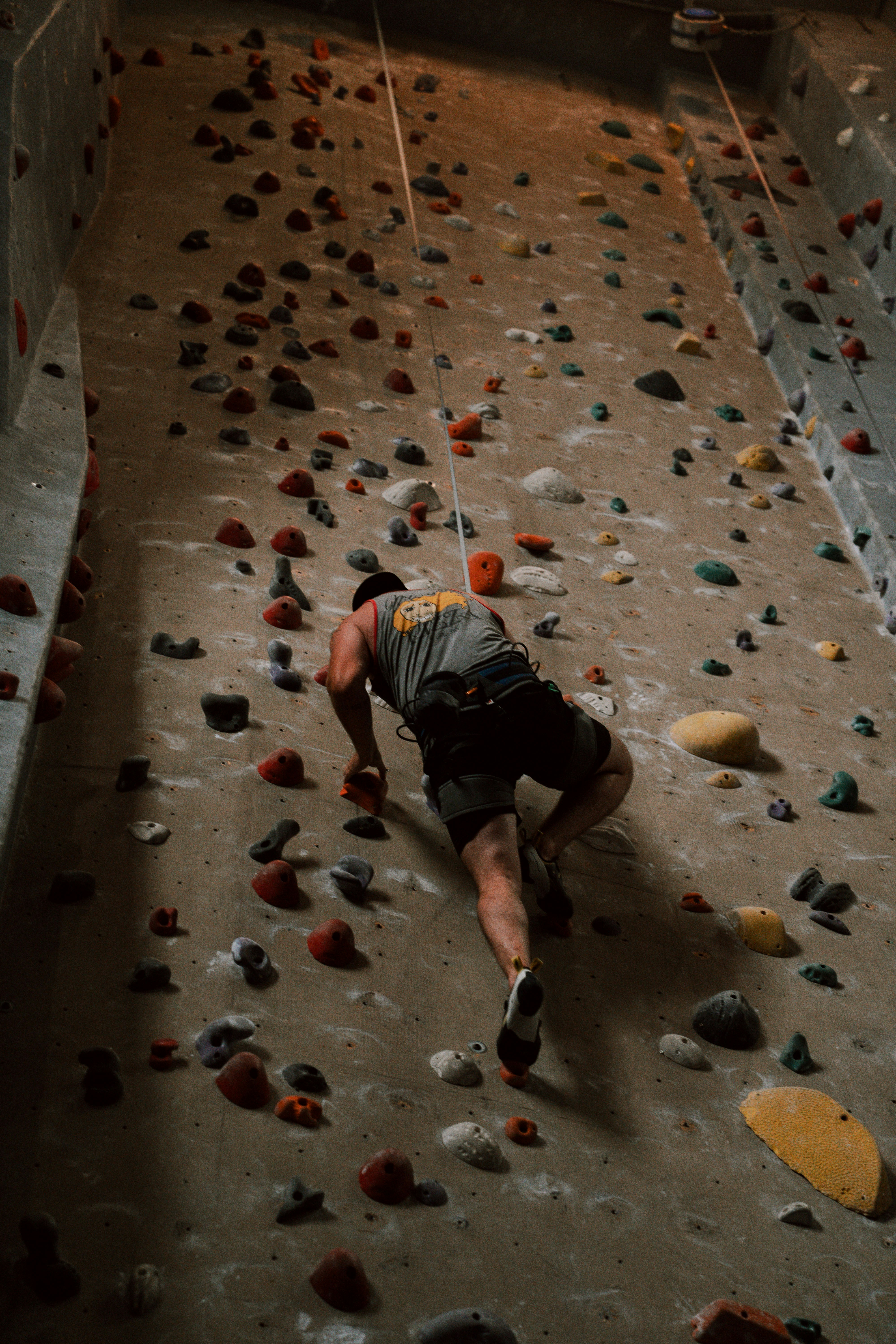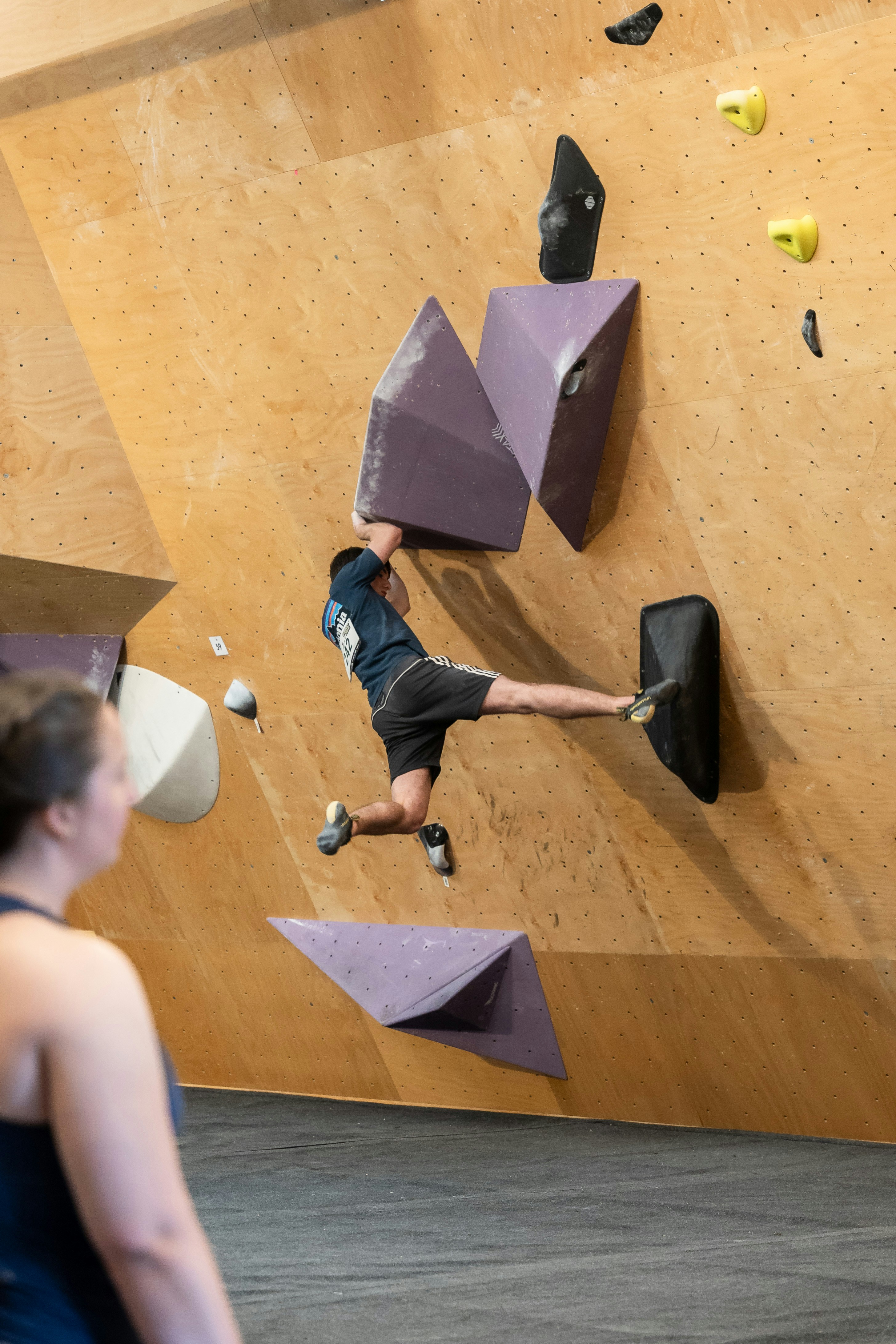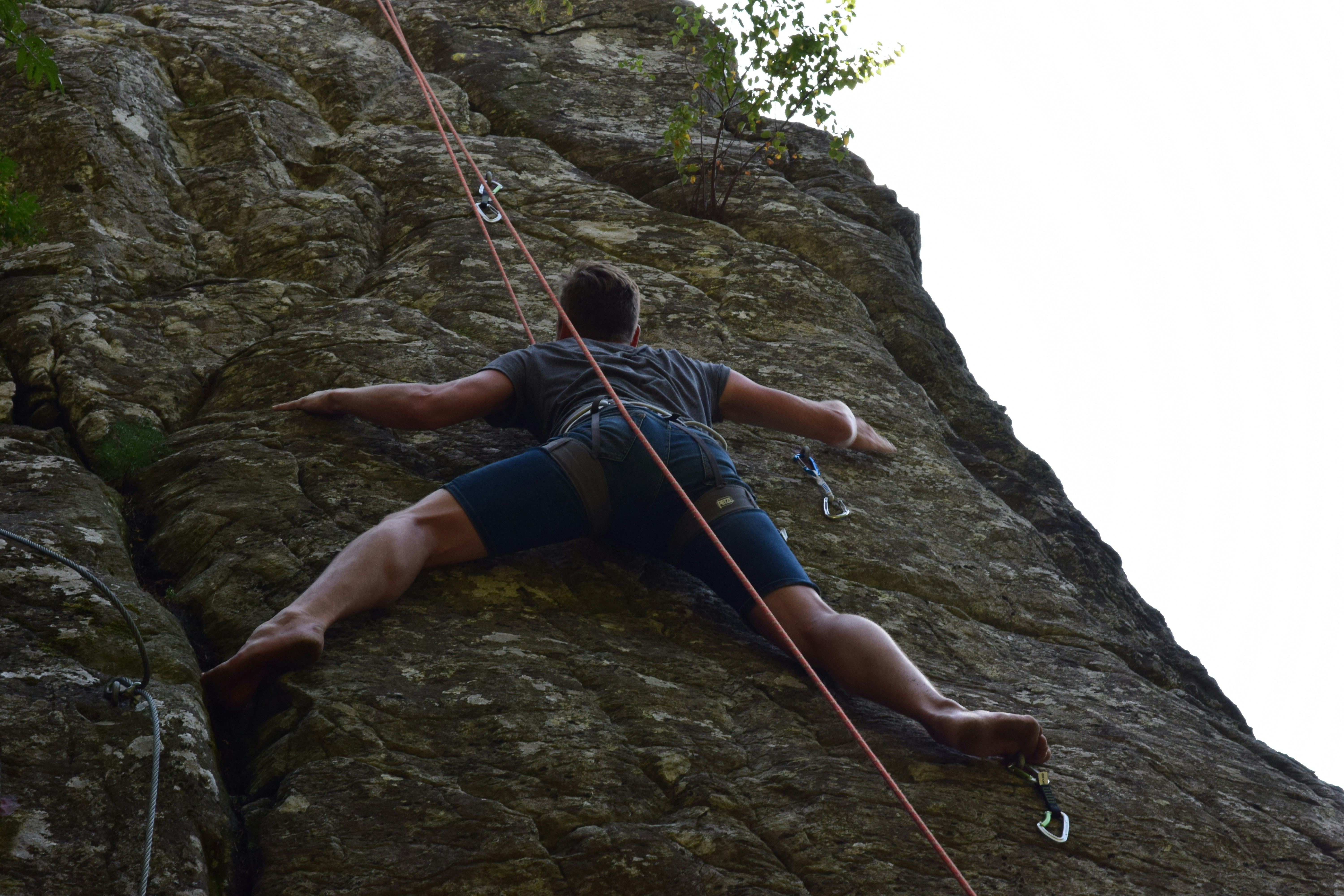You've probably heard it a thousand times - climbing is more about technique than strength. And that's absolutely true, until it isn't. There comes a point in every climber's progression where good technique can only take you so far, especially if you're eyeing competition climbing. The reality is that modern competition routes demand both exceptional technique and significant strength, often at the same time.
But here's where most climbers go wrong with strength training: they approach it like bodybuilders or general athletes. Competition climbing requires a very specific type of strength that's different from what you'd develop in a traditional gym. You need power that's functional on rock and plastic, strength that doesn't compromise your mobility, and conditioning that actually translates to better climbing performance.
The good news? You don't need to spend hours in the gym doing endless sets of exercises that barely relate to climbing. Smart strength training for competitive climbers is efficient, specific, and honestly pretty enjoyable once you understand what you're trying to accomplish.
Understanding Competition-Specific Strength Demands
Competition climbing has evolved dramatically over the past decade. Routes that would have been considered impossible are now standard at the elite level, and even local competitions feature moves that require significant strength endurance. The style of modern route setting emphasizes dynamic movement, compression holds, and sequences that demand power in awkward positions.
What makes competition climbing unique from outdoor climbing is the consistency of difficulty. On real rock, you might find rest positions or easier sections within hard routes. Competition routes are designed to be uniformly challenging from bottom to top. This means you need strength that can be sustained throughout entire problems or routes, not just for individual crux moves.
The holds have changed too. Modern competition holds are often designed to be challenging to grip, with subtle features that require specific finger strength and technique. Gone are the days when you could rely purely on massive jugs and straightforward pulling movements. Today's competition climbing demands strength in your fingers, forearms, shoulders, and core, all working together in complex movement patterns.
Another critical factor is the time pressure. In bouldering competitions, you have limited attempts to solve problems, which means you need to be strong enough to execute moves precisely from the first try. Lead competitions require you to climb efficiently without wasting energy on multiple attempts at sequences. This puts a premium on reliable, consistent strength rather than just peak power.
The Foundation: Fingerboard and Hangboard Training
Let's start with the obvious but often misunderstood cornerstone of climbing strength training - fingerboard work. Most climbers either avoid hangboard training entirely or approach it haphazardly. Both approaches leave significant gains on the table.
The key to effective fingerboard training is treating it like any other serious strength training protocol. That means consistent progressive overload, proper rest periods, and specific adaptation to your climbing goals. For competition climbing, your hangboard sessions should emphasize the grip positions you'll encounter most frequently in competition settings.
Start with basic dead hangs on edges that challenge you but allow for good form. Ten-second hangs are a good starting point, with the goal of eventually working up to 15-20 second holds. But duration isn't everything - adding weight while maintaining shorter hangs can be more beneficial for building the explosive strength needed for dynamic competition moves.
One protocol that works exceptionally well for competitive climbers is the max hang approach. This involves shorter hangs (5-10 seconds) with added weight, focusing on recruiting maximum strength rather than endurance. The nervous system adaptations from this type of training translate directly to being able to pull harder on competition holds.
Don't neglect asymmetrical loading either. Many competition moves require one hand to do significantly more work than the other, whether it's a long reach to a poor hold or a complex coordination sequence. Practice hanging with uneven weight distribution between your hands, and consider single-arm hangs as you develop the necessary strength base.
The timing of your hangboard sessions matters more than you might think. These should be done when you're fresh, typically at the beginning of training sessions or on dedicated strength days. Fingerboard work done when you're already tired from climbing often leads to poor form and limited adaptation.
Core Strength: The Hidden Engine of Competition Climbing
Core strength in climbing extends far beyond the typical understanding of "abs." Competition climbing demands incredible strength through your entire trunk, including your deep stabilizing muscles, obliques, and the often-neglected posterior chain. Modern competition routes frequently feature overhanging terrain where your core literally holds you onto the wall.
Traditional planks and crunches have their place, but they don't adequately prepare you for the specific demands of competition climbing. You need core strength that can function while your body is inverted, twisted, and often supporting significant load through one or two points of contact.
Front lever progressions are exceptionally valuable for competitive climbers. Even if you never achieve a full front lever, the progressions build exactly the type of core and back strength needed for steep competition routes. Tuck holds, advanced tuck holds, and straddle holds all develop strength in positions that directly translate to climbing movement.
L-sits and their variations address both core strength and hip flexor strength, both crucial for high steps and compression moves common in competition bouldering. Start with bent-knee holds and progress toward full L-sits, eventually adding movement like leg lifts or position changes.
Rotational strength is often overlooked but critical for competition climbing. Many modern competition moves require significant torso rotation while maintaining tension. Russian twists with weight, wood chop exercises, and rotational hanging exercises all build this capacity. The key is training rotation while maintaining stability, which mirrors the demands of climbing.
Don't forget about training your core in climbing-specific positions. Hanging knee raises, toes-to-bar, and various hanging L-sit progressions all build strength while suspended from your hands, which is exactly how you'll need to use this strength while climbing.
Upper Body Power: Beyond Basic Pull-ups
Upper body strength for competition climbing requires more nuance than simply getting stronger at pull-ups. While pull-ups remain valuable, the reality is that climbing rarely involves the pure vertical pulling motion that pull-ups train. Competition climbing is three-dimensional, with pulling occurring at various angles and often requiring simultaneous pushing or stabilization from other muscle groups.
Weighted pull-ups are still worth doing, but consider variations that better match climbing demands. Wide-grip pull-ups emphasize the lats and rear delts more effectively. Offset pull-ups, where one hand is higher than the other, train the strength asymmetries common in actual climbing. Archer pull-ups, where you pull primarily with one arm while the other assists minimally, bridge the gap toward single-arm pulling strength.
But competition climbing often requires more than just pulling. Mantle movements, where you push down and transition your weight over a hold, require significant pushing strength through unusual ranges of motion. Standard push-ups don't adequately address this need. Elevated push-ups with your feet higher than your hands better simulate the angles involved in mantling. Handstand push-up progressions develop overhead pushing strength that translates to pressing out roof sections and making high reaches from awkward positions.
Lock-off strength deserves special attention. This is your ability to hold a pulled position while reaching or adjusting. Competition routes often require you to lock off with one arm while making precise movements with the other. One-arm lock-offs are the gold standard here, but building up to them requires patience and progressive training. Start with assisted lock-offs using a pulley system or resistance bands.
Campusing - climbing without using your feet - builds explosive upper body power in a climbing-specific context. However, it's high-risk training that should only be attempted once you have a solid strength base. When done properly, campus board training develops the rapid force production needed for dynamic moves in competition climbing.
The often-overlooked aspect of upper body training for competition climbing is endurance. Competition routes don't just require peak strength - they require you to maintain that strength output for the duration of the climb. Circuit training that combines strength exercises with minimal rest can help bridge this gap.
Lower Body and Movement Integration
Lower body strength is criminally underrated in climbing circles, despite being crucial for competition success. Your legs are your largest muscle group and often your primary source of power for dynamic moves. Competition climbing frequently features high steps, heel hooks with significant load, and positions that demand substantial leg strength.
Single-leg strength is particularly important since climbing often requires you to stand on one foot while reaching or adjusting position. Bulgarian split squats, single-leg deadlifts, and step-ups all build the unilateral leg strength that translates directly to climbing performance. These exercises also improve balance and proprioception, which are critical for precise foot placement on competition holds.
Hip flexibility and strength go hand in hand for competition climbing. High steps require both the flexibility to achieve the position and the strength to stand up from it. Deep lunges, Cossack squats, and pistol squat progressions all address this combination of mobility and strength that's essential for modern competition routes.
Don't neglect your posterior chain - glutes and hamstrings. These muscles are crucial for generating power in heel hooks and for maintaining body tension on overhanging terrain. Deadlift variations, especially single-leg deadlifts, build this strength while also improving balance and coordination.
Plyometric training can help develop the explosive leg power needed for dynamic competition moves. Jump training - whether it's box jumps, broad jumps, or jumping lunges - develops the rapid force production that allows you to make big moves between holds. However, plyometrics should be approached carefully, with adequate recovery between sessions.
The integration aspect is where many climbers fall short in their strength training. All this strength needs to work together in fluid, climbing-specific movement patterns. Training that combines upper body, core, and lower body demands simultaneously will serve you better than isolated exercises. Think about exercises that require you to coordinate multiple muscle groups while maintaining balance and precision.
Periodization and Programming for Competitions
Strength training for competition climbing isn't just about what exercises you do - it's about when and how you do them. Proper periodization ensures that your strength peaks at the right time and doesn't interfere with your technical climbing development.
During base-building phases, strength training can be more frequent and comprehensive. This is when you develop your foundation of general strength that will support more specific training later. You might strength train 3-4 times per week during these phases, focusing on building capacity rather than peaking performance.
As competitions approach, your strength training should become more specific and less frequent. The principle here is that you want to maintain the strength you've built while allowing your body to focus energy on climbing-specific adaptations. Strength sessions might drop to 1-2 per week, with shorter, more intense sessions that maintain your gains without creating excessive fatigue.
Recovery becomes critically important as training intensity increases. Strength training creates significant demand on your nervous system, and insufficient recovery will compromise both your strength gains and your climbing performance. Pay attention to sleep quality, nutrition, and stress management - these factors significantly impact your ability to adapt to training stress.
The relationship between strength training and climbing volume needs careful management. Heavy strength sessions and hard climbing sessions both create significant demands on your body. Spacing these appropriately ensures that each training stimulus can create positive adaptations rather than just accumulating fatigue.
Consider your individual response to different types of training. Some climbers respond better to higher frequency strength training with lower intensity, while others thrive on less frequent but more intense sessions. Pay attention to how you feel, how you perform, and adjust accordingly.
Common Mistakes and How to Avoid Them
The biggest mistake competitive climbers make with strength training is treating it like climbing practice. Strength training and climbing serve different purposes and require different approaches. Strength training should be systematic, progressive, and focused on adaptation over time. Climbing practice should emphasize technique, movement quality, and route-specific skills.
Another common error is neglecting progression. Your body adapts to training stress, which means that the same workout that was challenging six months ago might not provide sufficient stimulus for continued improvement. Build progression into your strength training through increased weight, reps, difficulty, or complexity.
Many climbers also fall into the trap of training only their strengths or only their weaknesses. Balance is key - you need to maintain your strengths while addressing limitations. If you're naturally strong but lack power endurance, don't abandon strength training entirely in favor of endurance work. Instead, adjust the emphasis while maintaining both qualities.
Form breakdowns during strength training often go unnoticed but significantly impact both safety and effectiveness. Video yourself performing exercises, especially as fatigue sets in. Poor form not only reduces the training benefit but also increases injury risk. It's better to reduce load or reps than to compromise form.
Finally, many competitive climbers underestimate the importance of deload weeks and recovery phases. Continuous high-intensity training without adequate recovery leads to plateaus, burnout, and increased injury risk. Plan recovery into your training program just as systematically as you plan your strength sessions.
Putting It All Together
Effective strength training for competition climbing is about building a foundation that supports your climbing goals without overwhelming your recovery capacity. Start with the basics - consistent fingerboard training, functional core work, and upper body strength development. Add complexity and specificity as your base develops.
Remember that strength training is just one component of competition preparation. It should enhance your climbing, not replace it. The goal is to develop strength that translates to better climbing performance, not just impressive gym numbers.
Your strength training program should evolve with your climbing goals and competition calendar. What works during base-building phases needs to be adjusted as competitions approach. Stay flexible and responsive to how your body adapts to training stress.
Most importantly, be patient with the process. Significant strength adaptations take months and years to develop, not weeks. Consistency in your approach will serve you better than sporadic periods of intense training followed by neglect.
The climbers who excel in competition settings are those who develop strength systematically while maintaining their technical skills and movement quality. Strength training should feel like an investment in your climbing future, not a burden that detracts from your time on the wall. When approached correctly, it becomes an integral part of your climbing development that enhances every aspect of your performance.


